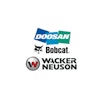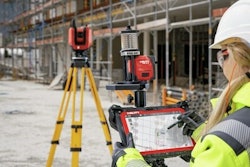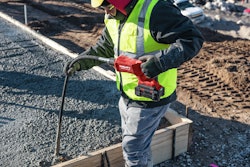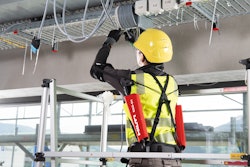
The COVID-19 pandemic has made construction site hygiene more important than ever. The experts at Hilti North America say clean tools, clean hands, and safe distancing are essential for your crew’s wellbeing. With routine cleaning and maintenance, rental business owners and users alike can help extend the tools’ lifespan, prevent unexpected downtime, and reduce safety hazards.
Depending on tool usage and the frequency of cleaning, the basic cleaning of a tool should take about two to three minutes. Advanced cleaning might take longer.
Before starting to clean, make sure that the tool is switched off and disconnected from any power source, including the battery. Refer to your company’s guidelines on protective equipment required when cleaning. Then:
- Remove coarse dirt with a brush or damp cloth. Using compressed air may expose you to airborne dust, so, as mentioned above, refer to your company’s guidelines for specific protective measures in this case.
- Scrape off any remaining dirt using a spatula. Be careful not to damage the tool housing.
- Remove grease or other residue from the surface of the equipment using a damp cloth:
- Dilute suitable soap in water to make a mild solution;
- Submerge a clean cloth in the solution and wring out until it stops dripping;
- Carefully wipe every outer surface – especially grips and handles. Ensure that no liquid flows into the tool.
- Allow the tool to dry completely before using.
Before using any chemical cleaning product, please read its instructions carefully to ensure your safety and to protect the tool. Chemicals such as hydrogen peroxide, chlorine-based fungicides, sanitary cleaners, acid/citric acids, descalers, or degreasers must not be used as they may damage the tool. Start with the steps for a routine clean, as mentioned above, and proceed as follows:
- Spray a cloth with either universal cleaner or disinfectant liquid until damp;
- Wipe the tool thoroughly, focusing on contact points such as grips and handles;
- Allow the recommended contact time to elapse (as stated in the cleaning product’s instructions);
- Wipe off any excess liquid immediately.
“These cleaning methods during the COVID pandemic are intended to further reinforce our focus on the worker safety and productivity of our customers,” said Michael Kennedy, SVP of Hilti North American Specialty Businesses, which includes Rental. “This also protects our Hilti team members when demonstrating our products based on our customers’ requirements in face-to-face interactions.”
While safe, this is also a cleaning procedure that will prevent damage to the tool. It does not necessarily mean the tool is completely disinfected though. Make sure to wash your hands thoroughly after contact with cleaning chemicals. Avoid touching your face with unwashed hands. Proper ventilation of the area is highly recommended and do not spray cleaning chemicals directly onto tools as this may cause damage.
Additional precautions are needed if blood is discovered on any tool or construction equipment. Please refer to your company’s protocols for bloodborne pathogens. Anyone tasked with this type of cleaning must trained in bloodborne pathogens and the use of specific PPE according to regulatory and/or company requirements.
Cleaning your rental equipment and tools is an important consideration for those around you, including your employees, customers, and friends and family. The precautions you take could be the difference between a healthy, successful business and the potential for incident.



















